Picture if you can Carthage and Rome in 300 BC
Carthage was on the northern African coast Rome well as most of us know is still in Italy I think it will be there a long time as well before it too goes under like most great civilisations do sadly
These two cities were neighbours and co-existed for centuries, of course it was inevitable than in the end hostilities commenced, the best of neighbours have their spats; this was not a mere spat.
Romans in that era confined their selves to rape looting call it what you will, in the end the Punic wars first started.
In those long ago days there was no money goods I guess was obtained by barter; quite a good system.
Carthage on the other had had expanded from mere bartering and was very wealthy in fact a very wealthy city; they really invented money.
Those greedy Romans had their eyes on this; does this sound familiar it certainly does to me however back to Carthage and Rome.
Rome wanted in on this grandiose scheme naturally and figured quite wrongly that Carthage would share this, what a joke.
In actual fact which I unearthed at a library in Maroochydore 265 BC was the turning point, the devious Romans started the first of the Punic wars some twenty two years of warfare to relieve Carthage of some of her cash etc.
When the dust settled, Rome was the proud new owner of Sicily, Sardinia, and Corsica. She also received four million in Carthaginian currency as compensation. Everybody was grateful the ruckus was over, and settled back to enjoy the next twenty-two years of peace so they thought.
This brings us to the story of a mighty Carthaginian General called Hamilcar; this bloke looked a real idiot by stranding his entire army on top of a Sicilian mountain
Hamilcar's friends managed to liberate him.
Hamilcar's favourite strategy involved using elephants to scare his enemies, quite a lot of them.
He instructed his son in military tactics using these huge beasts, he always emphasised the need for a great herd, and he even reckoned he would have won the First Punic War if he had been given more of these mighty beasts.
The decisive battle of the Punic War was a naval one so his lessons seemed rather absurd, Ironically, Hamilcar drowned in 228BC on the back of an elephant.
After his father's death, Hannibal awoke, he had a well-trained army, and with his father's herd, he set out for Rome to seek vengeance.
The idea was to sneak over the Alps with his Jumbos, and surprise the Romans.
This started the second Punic war
Sneaking his army and thirty-seven elephants over the Alps was not as easy as he figured the gruelling fifteen day march cost him half his army; it did not surprise the Romans either who upon hearing the grunting and cursing in the foothills, quickly moved into strategic positions.
The second Punic War was under way. The battles raged up and down the Italian coast for the next fifteen years.
Hannibal lost many elephants; he always seemed to score a few to replace the ones he had lost until the battle of Trasimene.
Without an elephant to his name, Hannibal was finished.
He had more luck on the battlefield without elephants, but Hannibal had lost his spirit. He did win several victories, but couldn't bring himself to move on Rome itself; he returned to Carthage as elephants were not getting to him for all manner of reasons.
Once Hannibal was out of Italy, the Romans pulled themselves together.
They figured the Second Punic War needed a happy ending, so they set sail for Carthage.
Hannibal was suddenly a popular bloke his neighbours lined up at his front door, and pledged all their elephants if he would only take up the cause.
Hannibal in a short time was at the head of an eighty elephant herd and given command of a very large army of soldiers.
Relying on his favourite strategy, Hannibal headed the charge with his herd of elephants. His troops marched behind the bellowing herd. The elephants took one look at the Roman legions, and decided to return to the stable as quickly as possible.
Carthaginian casualties from the elephant retreat were enormous. The Roman legions quickly wiped out the few bewildered soldiers the elephants had missed.
Hannibal was offered early retirement at the age of forty-five, He wanted to get his countrymen to start a Third Punic War whinged about it for a few years but the Carthaginians just weren't in the mood.
So that is the real story of Hannibal and below here is a video courtesy of the BBC to show you these mighty beasts in those far off days you can read about these elephants here
Comments even anonymous are quite welcome


































